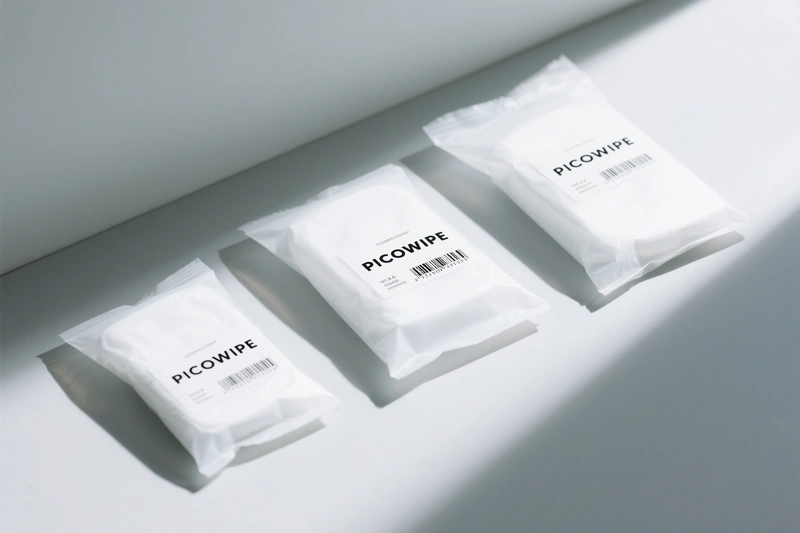By [email protected] — Charting the depths of expertise
Nonwoven cleanroom wipes generally shed several times more particles than woven or knitted cleanroom wipes. This difference stems from fundamental distinctions in core aspects like raw materials, construction processes, edge treatments, and post-processing. A detailed analysis follows:
I. Raw Materials: Staple Fibers vs. Continuous Filaments (Core Reason)
| Category | Material Composition | Shedding Analysis |
|---|---|---|
| Nonwoven Cleanroom Wipe | Typically 55% Cellulose (Wood Pulp) + 45% Polyester Staple Fiber | Cellulose consists of 1-4mm natural staple fibers with low strength and poor abrasion resistance, prone to breaking and shedding – the primary source of lint. |
| Cleanroom Wipe | 100% Continuous Filament Polyester / Polyester + Nylon Microfiber | Filaments are virtually endless, smooth, uniform in diameter, and extremely strong, eliminating lint generated from shedding staple fiber ends at the source. |
II. Structure & Process: Adhesive Bonding vs. Mechanical Interlocking
Nonwoven Cleanroom Wipes: Utilize air-laid / spunlace processes. Fibers are arranged in a random, three-dimensional web, resulting in a relatively bulky and non-uniform structure. Cellulose and polyester are often bound using adhesives (latex, chemical emulsions) or thermal bonding fibers. Adhesives can fracture under friction, generating micro-particles, and the fiber-binder interface represents a weak point.
Cleanroom Wipes (Woven / Knitted): Employ knitting (e.g., double-knitted) or weaving processes. Continuous filament fibers (yarns) are physically interlinked (e.g., knit loops) to form a regular, stable, and robust mechanical interlocking structure. Bond strength comes from the fibers themselves and the fabric structure, without external binders. This results in high abrasion resistance and makes fibers difficult to dislodge.
III. Edge Treatment: Mechanical Cutting vs. Thermal Sealing (Key Failure Point)
Nonwoven Cleanroom Wipes: Can only be mechanically cut. Cutting severs fibers and cured binders, leaving numerous loose fiber ends and binder fragments at the edge – the main source of particle release (Cellulose burns when heated, making thermal sealing impossible).
Cleanroom Wipes: Leverage the thermoplastic nature of polyester. Edges are sealed using laser, ultrasonic, or thermal cut methods. High temperatures melt and solidify the edge fibers, creating a strong, sealed border that physically locks in fiber ends and prevents edge shedding.
IV. Post-Processing: No Washing vs. Ultrapure Water Washing (Cleanliness Assurance)
Nonwoven Cleanroom Wipes: Processed and packaged in a clean environment but without rigorous washing. Micro-particles and loose fibers adhered during production are carried into the final product.
Cleanroom Wipes (High Grade, e.g., Class 100 / ISO 5): After cutting and sealing, they undergo repeated washing and drying with 18-megohm ultrapure water in a Class 100 cleanroom. This removes soluble residues (NVR), ionic contaminants, and surface particles, ensuring high cleanliness.
V. Physical Properties
Cleanroom wipes exhibit far superior tensile strength, tear strength, and abrasion resistance compared to nonwoven wipes. Cleanroom wipes have smoother surfaces with fewer exposed fiber ends, whereas nonwoven surfaces are rougher.
Nonwoven cleanroom wipes are sensitive to temperature and humidity, and binders can be compromised by solvents like IPA. Cleanroom wipes tolerate temperature/humidity changes well and offer excellent resistance to common chemical solvents.
Conclusion
Nonwoven cleanroom wipes have multiple sources of shedding (e.g., staple fiber release, binder fracture, edge debris). Cleanroom wipes typically only shed particles under extreme abrasion or if the edge seal fails. Therefore, nonwoven cleanroom wipes generally have a particle shedding rate several times higher than woven or knitted cleanroom wipes.


